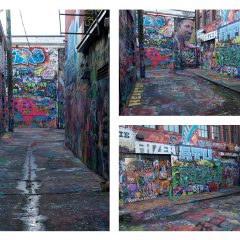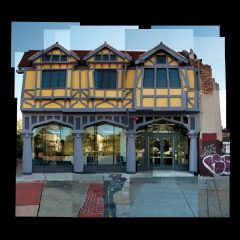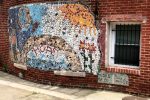Artblog is running images of art from the Detroit Institute of Art today as part of an online day of solidarity for the museum. The effort to shine light on the DIA is organized by Tyler Green. The internet project, called A Day for Detroit, will bring public awareness to the plight of the endangered public art museum in an endangered and bankrupt American city that is ooking to sell assets (including works from the DIA’s collection). We in Philadelphia remember when a local institution wanted to sell one of our local cultural and historical touchstones, Thomas Eakins’ The Gross Clinic. Many people and institutions here and from outside the city rose up and helped our two major museums buy the work, which is now happily ensconced at one or the other museum, traveling at intervals back and forth. It’s a great piece of our cultural legacy and to have lost it would have been a crime against our civic identity. Likewise, selling off pieces of Detroit’s cultural legacy by cashing in on the million-dollar paintings the DIA holds would be a crime against that city’s civic identity.
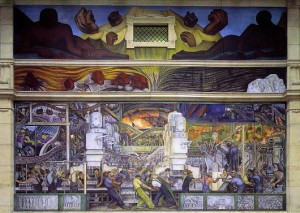
Green’s purpose is to focus world attention on the “great works that would be lost to Detroit if a bankruptcy sale goes through.” He says, “The DIA is a cornerstone institution around which the city can recover — and those of you who have been to Detroit recently have seen how the area anchored by the DIA has been recovering, thanks substantially to the presence of the DIA, the CCA, an on-the-rise MOCAD…”
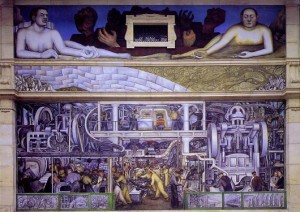
I’ve been to the DIA. It’s a magnificent place with a vast encyclopedic collection and a jaw-dropping mural by Diego Rivera “Detroit Industry.” The mural is an example of how a great museum can inspire, thrill, educate and uplift the citizenry. The mural inhabits a vast atrium space that is grandiose, formal and chill. It’s a weirdly wonderful site for the hot, emotional mural, providing a solemn backdrop for Rivera’s heady history lesson of commerce and industry (which can be read as celebratory or not).
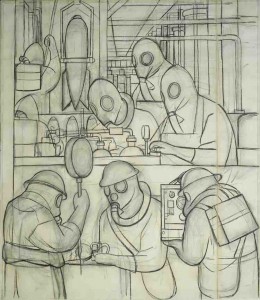
Diego M. Rivera, Mexican, 1886-1957; Cartoon of Manufacture of Poisonous Gas Bombs (Detroit Industry north wall), 1932, charcoal. Gift of the artist (33.36).
In addition to the mural, the DIA has in its collection the drawings Rivera made for the mural. This summer, the museum, with a grant from Bank of America, digitally scanned and conserved the life size cartoon drawings. Who even knew there were such things in existence! These are fragile drawings, given to the museum by the artist, and usually held in a climate-controlled room. They were last on view to the public in 1986. According to the museum’s website “Rivera drew the 13 cartoons in 1932 in preparation for the murals and gave them to the museum upon completion of the work. Five of the drawings will be part of a 2015 exhibition at the DIA featuring the work of Rivera and Frida Kahlo created during their time in Detroit.”
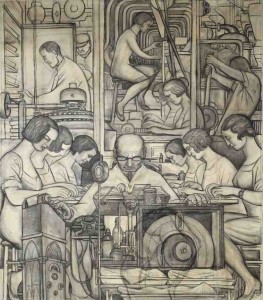
Diego M. Rivera, Mexican, 1886-1957; Cartoon of Pharmaceutics (Detroit Industry south wall), 1932, charcoal. Gift of the artist (33.37).
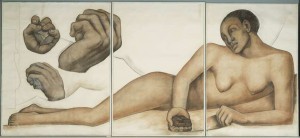
Diego M. Rivera, Mexican, 1886-1957; Cartoon of Figure Representing the Black Race (Second Version) (Detroit Industry south wall), 1932, brown and red pigment with charcoal, over light charcoal. Gift of the artist (33.38).
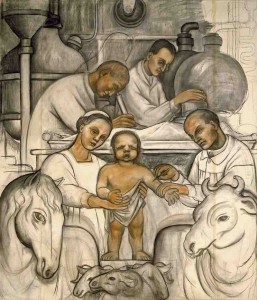
Diego M. Rivera, Mexican, 1886-1957; Cartoon of Vaccination (Detroit Industry north wall), 1932, charcoal with red pigment over light charcoal. Gift of the artist (33.41).

Diego M. Rivera, Mexican, 1886-1957; Cartoon of Infant in the Bulb of a Plant (Detroit Industry east wall), 1932, charcoal with brown pigment over light charcoal. Gift of the artist (33.35).
We at artblog are rooting for Detroit to pull out of bankruptcy and turn itself around. We hope DIA comes out of it unscathed. If you want to do something to help, Tyler suggests becoming a member of the DIA. It costs $65. See more images from the Detroit Institute of Art at these participating blogs: Modern Art Notes, Art F City, Hyperallergic, Two Coats of Paint, and Bad at Sports.



